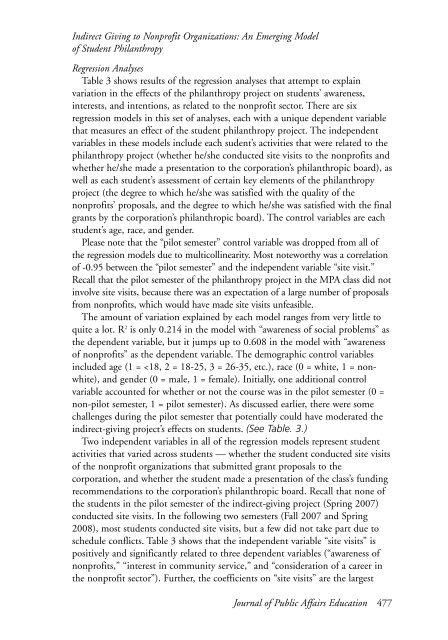JOURNAL OF PUBLIC AFFAIRS EDUCATION - National ...
JOURNAL OF PUBLIC AFFAIRS EDUCATION - National ...
JOURNAL OF PUBLIC AFFAIRS EDUCATION - National ...
You also want an ePaper? Increase the reach of your titles
YUMPU automatically turns print PDFs into web optimized ePapers that Google loves.
Indirect Giving to Nonprofit Organizations: An Emerging Model<br />
of Student Philanthropy<br />
Regression Analyses<br />
Table 3 shows results of the regression analyses that attempt to explain<br />
variation in the effects of the philanthropy project on students’ awareness,<br />
interests, and intentions, as related to the nonprofit sector. There are six<br />
regression models in this set of analyses, each with a unique dependent variable<br />
that measures an effect of the student philanthropy project. The independent<br />
variables in these models include each sudent’s activities that were related to the<br />
philanthropy project (whether he/she conducted site visits to the nonprofits and<br />
whether he/she made a presentation to the corporation’s philanthropic board), as<br />
well as each student’s assessment of certain key elements of the philanthropy<br />
project (the degree to which he/she was satisfied with the quality of the<br />
nonprofits’ proposals, and the degree to which he/she was satisfied with the final<br />
grants by the corporation’s philanthropic board). The control variables are each<br />
student’s age, race, and gender.<br />
Please note that the “pilot semester” control variable was dropped from all of<br />
the regression models due to multicollinearity. Most noteworthy was a correlation<br />
of -0.95 between the “pilot semester” and the independent variable “site visit.”<br />
Recall that the pilot semester of the philanthropy project in the MPA class did not<br />
involve site visits, because there was an expectation of a large number of proposals<br />
from nonprofits, which would have made site visits unfeasible.<br />
The amount of variation explained by each model ranges from very little to<br />
quite a lot. R 2 is only 0.214 in the model with “awareness of social problems” as<br />
the dependent variable, but it jumps up to 0.608 in the model with “awareness<br />
of nonprofits” as the dependent variable. The demographic control variables<br />
included age (1 =

















